🧪 Herbicides
Classification, Formulations, Mode of Action, Adjuvants, Methods of Application, Herbicide Selectivity and much more.
Classification of Herbicides
A) Acc. to Selectivity of Herbicides
- Selective herbicides:
2,4-D,Simazine,Atrazin,Butachlor,Pendimethalin,Fluchloralin,Fenoxaprop,Isoproturonetc. - Non-selective herbicides:
Diquat,Paraquatetc.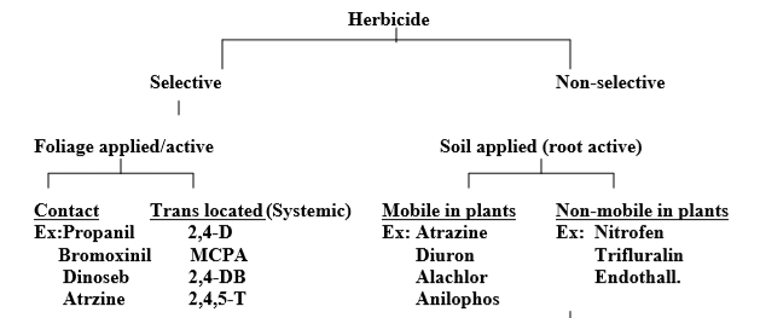
B) Time of Application of Herbicides
- Fallow application: Application of herbicides well in advance of sowing i.e., >10 days before sowing. It is applied for problematic weeds with higher dose.
- Pre-plant incorporation (PPI): Applied 1 days before sowing/planting i.e.,
Fluchloralin (Basalin),Alachlor (Lasso)etc. - Pre-emergence (PE): 1-4 days after sowing i.e.,
Simazine,Atrazin,Butachlor,Pendimethalin,Alachlore,Chlorimuronetc. - Post-emergence: 30-40 DAS, i.e.,
2, 4-D,Diquat,Paraquat,Isoproturon,Dalapan,Sulfosulfuron,Fenoxaprop ethyl.
C) On the Basis of Chemical Structure
Inorganic: First chemical used, Arsenic, Sodium Sulphuric acid, Sodium arsenate, Sodium chlorate, Borax, Copper sulphate, Copper nitrate etc.
Organic Herbicides: 16 to 17 group

Trade Name of Different Herbicides
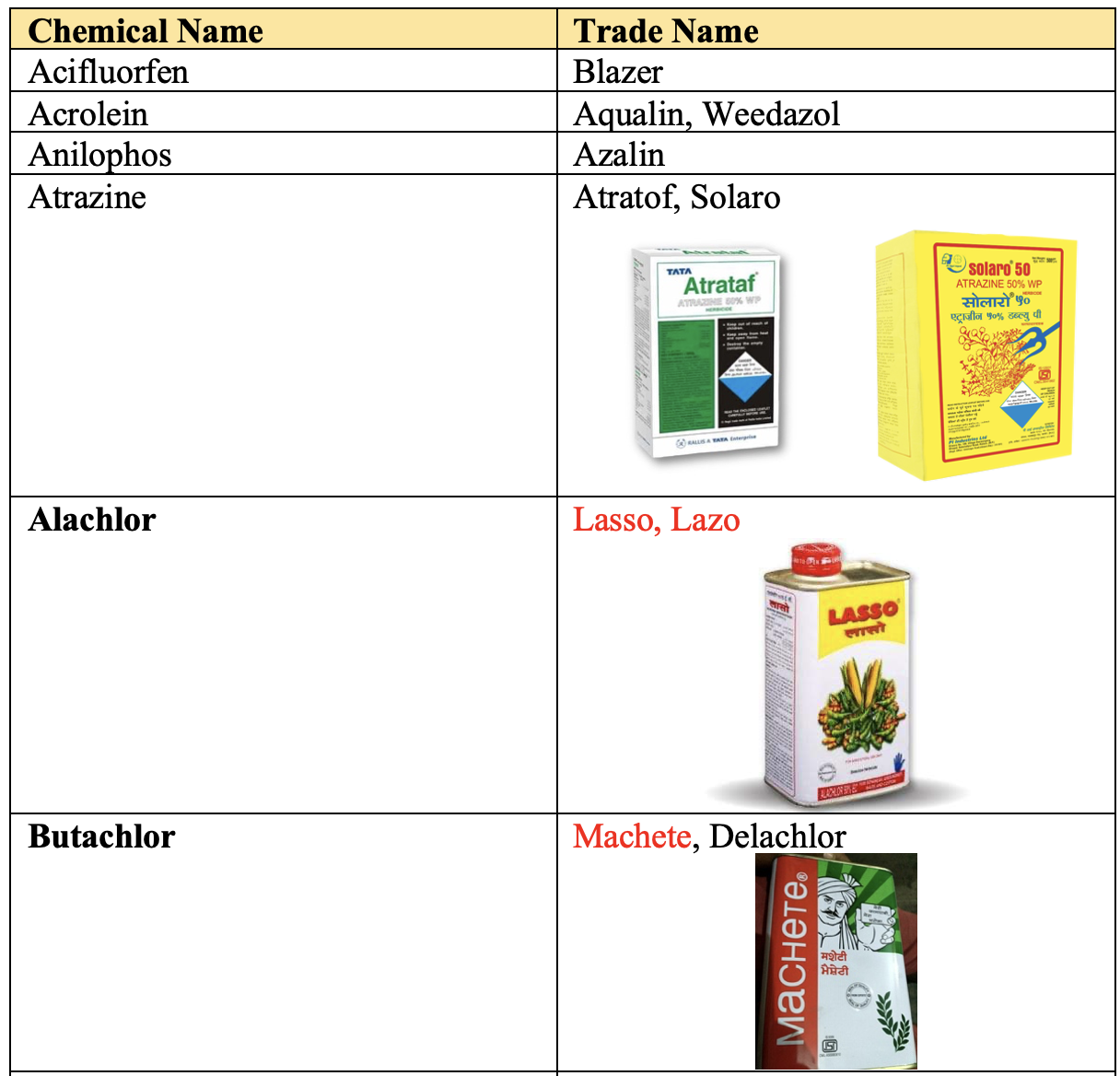
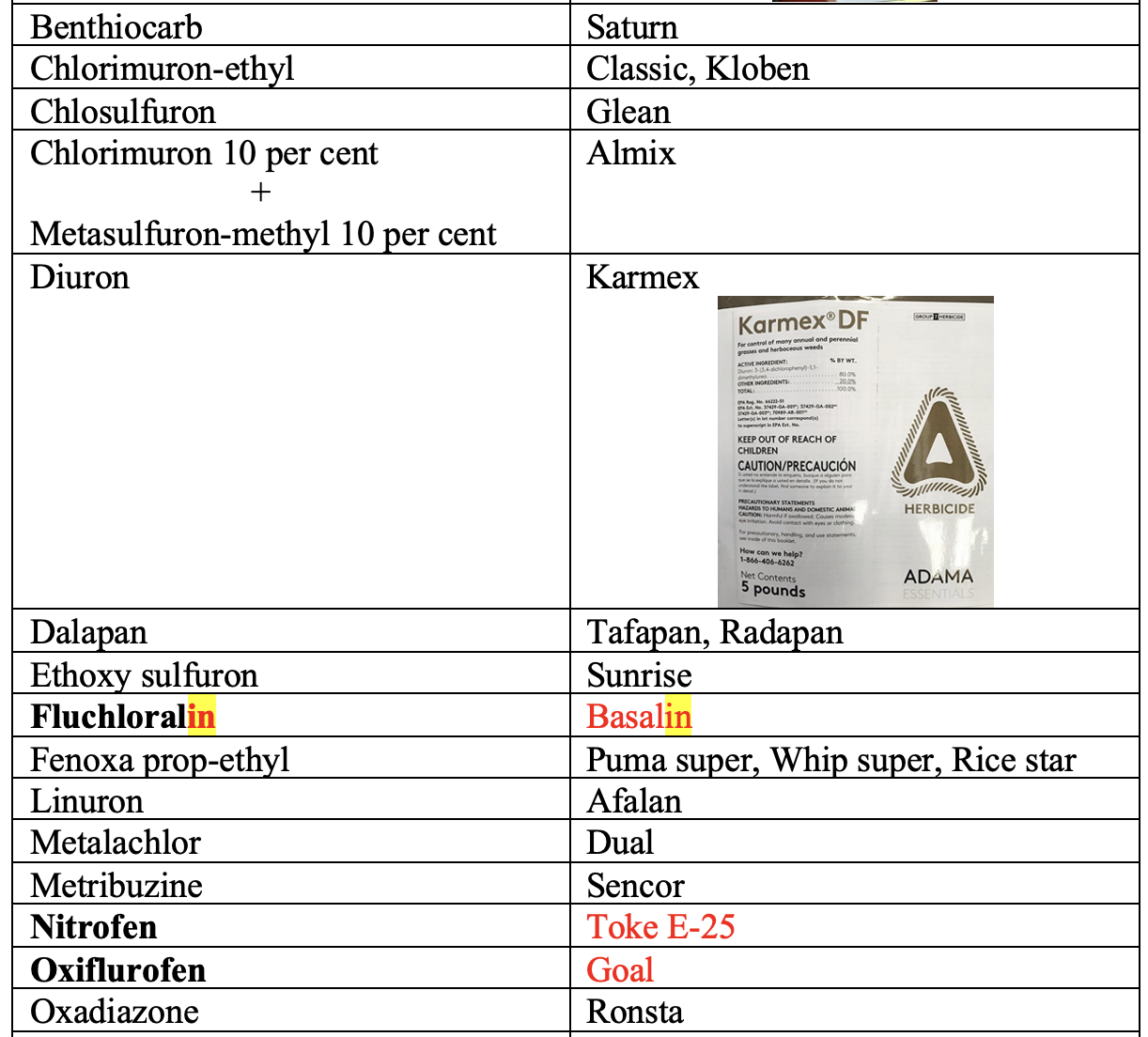


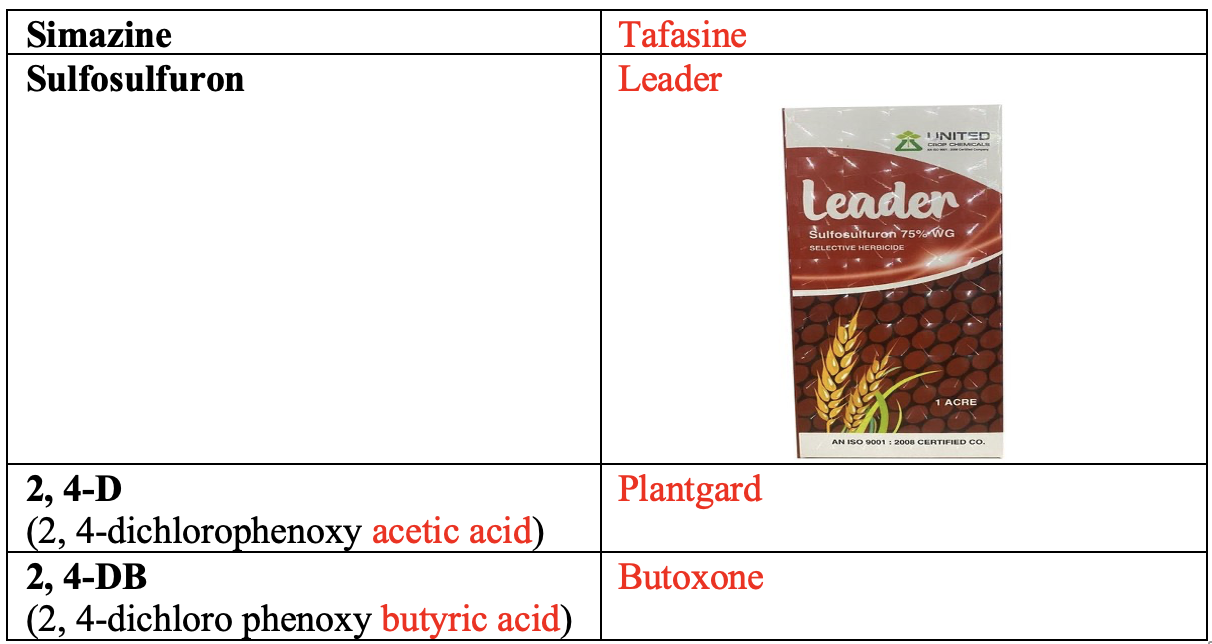
D). On the basis of Selectivity
- Selective herbicide: “When an herbicide is applied in a mixed plant population, herbicide harm or kill target weeds whereas crop-plants are not affected. This phenomenon is called selectivity”.
- Selective herbicides are used in crop areas, lawns, gardens, and grasslands. e.g.
Simazine,Atrazine,2, 4-D,MCPA,EPTC,Butachlor,Pendimethalin,Alachlor,Fluchloralin,Trifluralin,Isoproturonetc. - Recommended dose of Atrazine (0.5-1.0 kg/ha) kills weeds of sorghum, means it acts as selective herbicide. But when Atrazine is applied at 10 kg/ha, it is nonselective in nature.
- Non-selective herbicide: It is one that kills plants without regard to species, for example,
Paraquat,Diquat,Sodium chlorate,Weed oils, andAcrolein. The non-selective herbicides are employed for general vegetation control on industrial sites, fallow land, and in aquatics and tennis courts.
✭ Certain selective herbicides when applied at high rates, can act as non-selective plant killers, for instance, Simazine and Diuron.
Paraquatis the contact, non-selective and zero persistent herbicide in soils.
E). On the basis of Translocation
- Systemic herbicide: Such herbicides move within the weed either through xylem or phloem and thus affect the whole system like photosynthesis & respiration. Most of the systematic herbicides are selective at recommended dose e.g.
Propanil,2,4-D,Atrazine,Simazine. - Contact herbicide: Kills the vegetation either weeds or crops when it comes in contact. lt kills the part of the plant that is in contact with herbicide e.g.
Paraquat&Diquat.
F). On the basis of time of application
- Pre-plant applied: Such herbicides are applied
before planting of cropin field e.g.Fluchloralin(Basalin) &Alachlor(Laso). - Pre-emergence: Applied
before emergence of weedsbut post emergence of crops e.g. only selective herbicides. - Post-emergence: Applied
after the emergence of weed(and also crop) e.g.2,4 D,Propanil,Diquat,Paraquat,Dalapon.
G). On the basis of Method of application
- Foliage: It may be either contact or translocated.
- Soil applied: Either selective or nonselective.
- Aquatic application: e.g. Copper sulphate, 2,4-D.
H). Toxicity
- Herbicides have low residual toxicity –
Diquat,Paraquate - Herbicides have high residual toxicity –
Diuron,Atrazine,Triazineherbicides are said as notorious herbicide because of - Long residual toxicity.
Synergistic Effect
- Atrazine + 2, 4-D (low conc.)
- Atrazine + Alachlor (widely used in corn).
- Paraquat (low) + Pentachlor.
Antagonistic Effect
Generally, contact + systemic herbicide combination shows antagonistic effect.
- Dalapon + Atrazine
- TCA + 2, 4-D
- TCA + MCPA
Herbicidal Resistance of Weeds
- “Natural occurring habitat ability of some weeds biotypes within a population to survive against an herbicidal treatment”.
- Ex. Phalaris minor –
Isoproturon(in Punjab) - Echinochloa sp. –
Propanil Triazinestolerate broad leafy weed biotype – Chenopodium album.Chlorfenacherbicide has the longest persistency.
Toxicity Category of Herbicides

Formulations
- Soluble Powder (S.P.) - 2, 4-D sodium salt, Dalapan, TCA
- Soluble Concentrates (S.C.) - 2, 4-D amine aster, Diquat, Paraquat
- Wettable Powder (W.P.) - Atrazine 80 per cent, Simazine 50 per cent, Isoproturan 70WP
- Liquid Suspension - Atrazine, Cyprazin, Nitralin
- Emulsifiable Concentration (E.C.) - 2, 4-D ester, Alachlor, Nitrofen
- Granules - Granules of Butachlor, 2, 4-DEE
Active Ingredient (A.I.):
- Chemical in commercial product that is directly responsible for the herbicidal activity is called active ingredient. Generally expressed as percentage by weight or by volume.

Acid Equivalent (A.E.)
- Some herbicides are active organic acids like phenoxy acetic acid, picloram & chloramben. But many of these are generally supplied in the form of their salts and esters e.g. instead of 2, 4- D, in acid form, sodium salt or amine salt or ester form is used.
- The theoretical yield of parent acid from such an herbicide formulation is called its
acid equivalent. - The acid equivalent of sodium salt of 2,4-D is 92.5%. It means 2,4-D is 92.5% in sodium salt of 2,4-D and a.e. is less than A.I.
Q. A product has 80% A.E. to apply 2 kg A.E. /ha. What will be the quantity of formulation required. Solution: To provide 80 kg a.e. 100 kg formulation is required. To provide 2 kg a.e. 100/80 x 2 = 2.5 kg/ha
Q. One has to apply 0.5 kg a.i./ha of 80% atrazine then quantity of atrazine required would be (a) 0.40kg (b) 0.48kg (c) 0.52kg (d) 0.62kg/ha Solution: 80kg aitrazine is available in its 100 kg formulation 0.5 kg atrazine is available in its 100/80 x 0.5=0.62kg/ha.
Herbicides Mode of Action
Mode of action of herbicides indicates that how the herbicide kills or inhibits growth of plants.
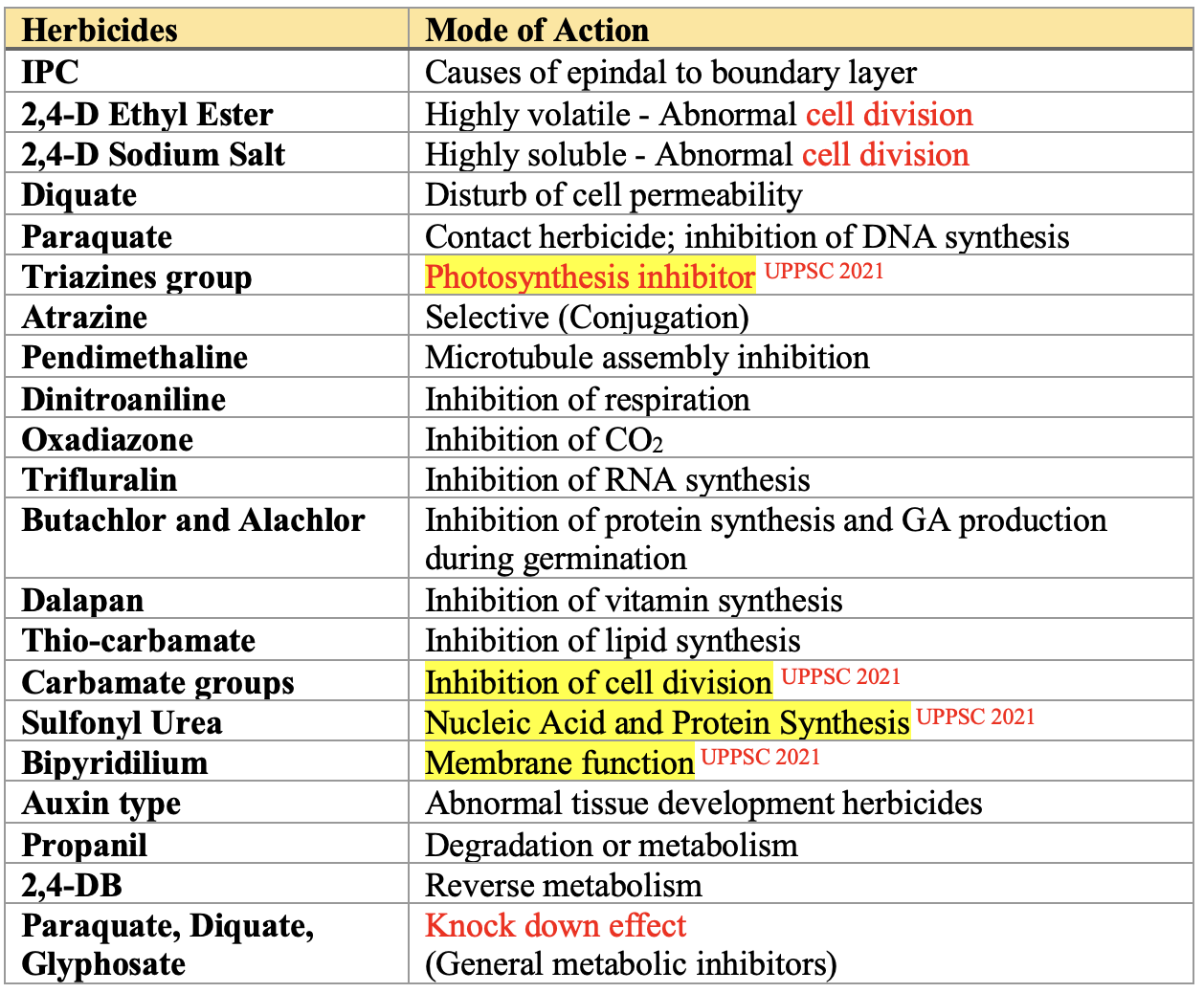
- ⭐️
Apoplastherbicides absorb through roots, whileSymplastherbicides through shoots and foliage. - ⭐️ Herbicides move or absorbed faster in young plants than in old ones.
Herbicides for Weed control in different Crops
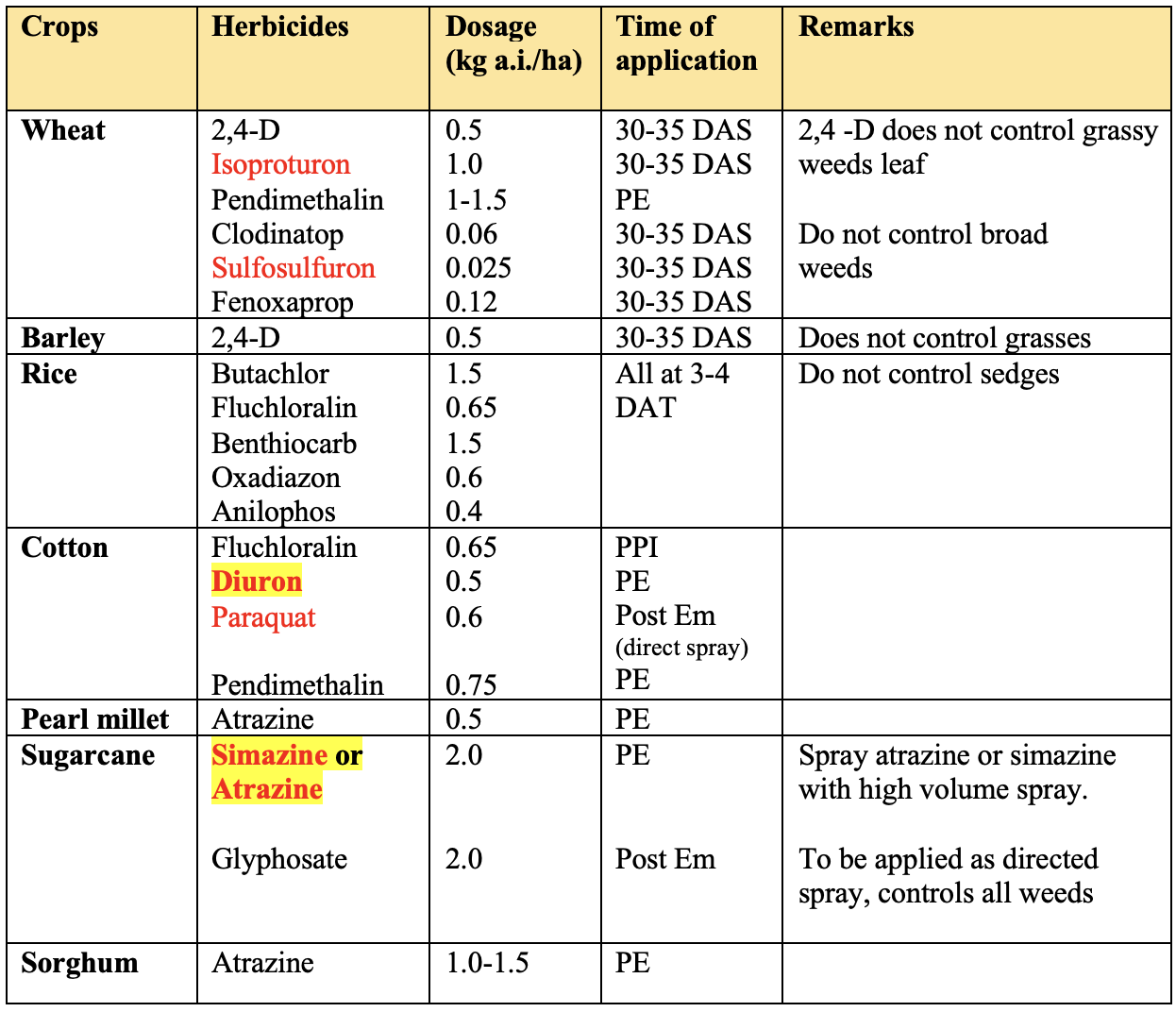
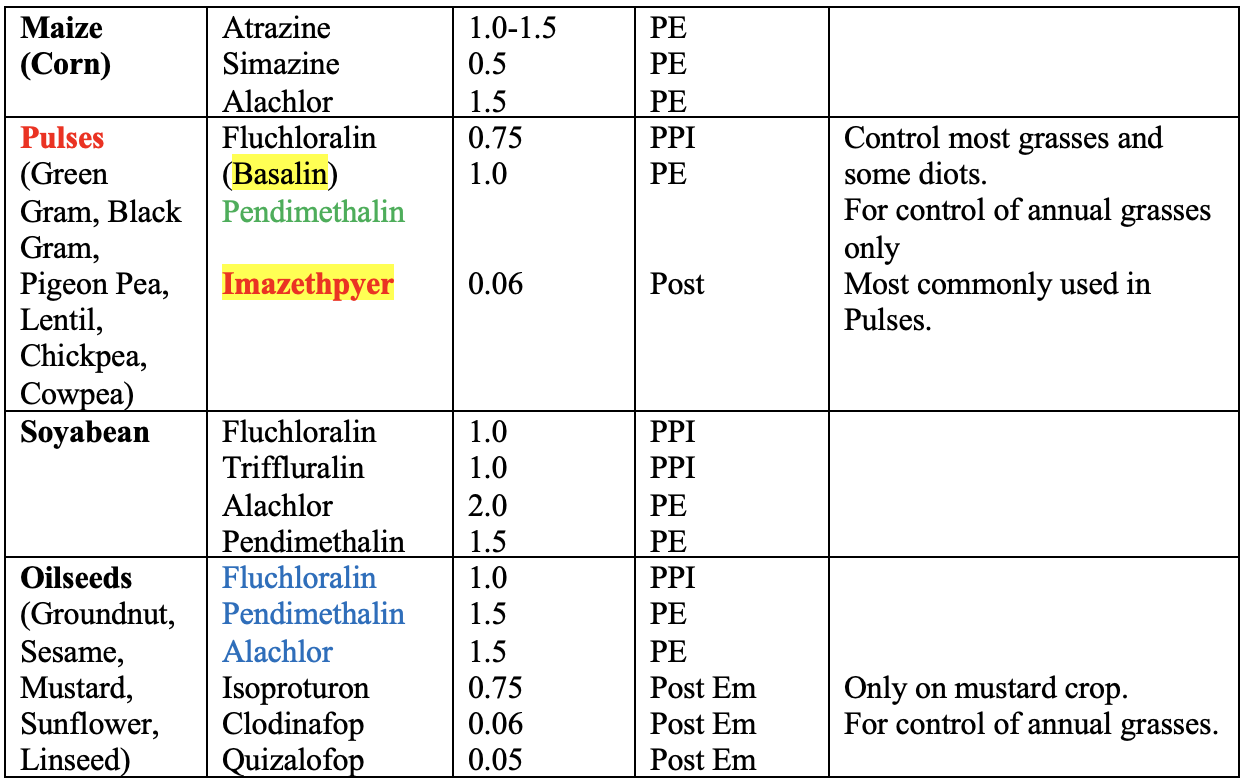
Methods of Herbicides Application
A) Soil Application
- Soil surface application: Most of the
Triazines,UreasandAmidegroup. - Soil application: Anilines group i.e.
Fluchloralines. - Sub-surface application: Only for deep rooted and perennial weeds.
- Band application: Weeds in
Maize(spraying of Atrazine). - ⭐️Lay by application: It is the application of herbicide
after the last cultivationof crops i.e. earthing up in sugarcane.
B) Folier Application
- Blanket application: Application of herbicides over the entire leaf area (only selective herbicides).
- Direct application: Application of herbicides in between the crop rows directly towards weeds.
- Spot application: Herbicide solution is poured on weeds in cropped and non-cropped fields infested with obnoxious weeds in isolated patches.
- Basal application: Brush wood and unwanted trees are treated with herbicides. Generally, the bark of the trees at the base of the stem up to 30 cm height is removed and a drenching spray of herbicides is given to the base.
C) Herbigation
👉🏻 Application of herbicide 🧪 along with irrigation💧 eg. Benthiocarb in paddy.
Adjuvants
- “Materials or chemicals which are added to herbicides in order
to improve herbicidal effectsandnot to increase the innate activityof the herbicide”. - Or “Any substance in an herbicide formulation or added to the spray tank to modify herbicidal activity or application characteristics”.
- Or Chemicals employed to improve herbicidal effects are called adjuvants.
- Adjuvants do not act by increasing the innate activity of herbicide.
- Adjuvants enhances the activity of herbicide in the plants where it is needed.
Uses
- To improve the selectivity to non-target plants.
- To render herbicide safer to user.
- To prolong shelf life of herbicide concentration.
- To reduce drift hazards.
Kinds of Adjuvants
There are numerous types (or functions) of adjuvants.
- Surfactants
- Stabilizing agents
- Solvents
- Humectants
- Stickers
- Compatibility agents
- Activators
- Drift control agents
Surfactants
- A material that improves the emulsifying, dispersing, spreading, wetting, or other properties of a liquid by modifying its
surface characteristics” is known as Surfactant. (Also known assurface active agents) are the largest class of adjuvants. They modify the surface properties. - They perform three functions i.e.,
wetting,spreading&penetration. - Surfactants can be non-ionic, anionic, cationic or amphoteric. Most surfactants are non-ionic (NIS); they do not ionize.
- A surfactant molecule has both hydrophilic (water-loving) and lipophillic (oil loving) characteristics.
- Surfactants aid in the mixing of water and lipophillic substances by aligning at the interface, with the hydrophilic head associated with water and the lipophillic tail associated with the lipophillic (oily, waxy) material.
Stabilizing Agents
a) Emulsifiers
An emulsifier’s causes an emulsion concentration to disperse spontaneously into small, stable droplets when added to water.
b) Dispersent
Stabilize the suspension. They keep fine particles of wettable powders in suspension in water, even after initial vigorous agitation is withdrawn from spray tank.
Solvents and Co-solvents/Coupling Agents
Chemical that is added to solubilise an herbicide in a concentration form. So that the resulting solution is soluble with water in all proportions. 2, 4-D is insoluble in water but it is dissolved in PEG to make it soluble. Lanolin, carbowax, benzene, xylene, petroleum, ether, CCl4, methyl chloride, alcohols, acetones are coupling agent.
Humicants / Hygroscopic Agents
They prevent rapid drying of herbicides spray on foliage there by providing an extended opportunity of herbicidal absorption. Being hygroscopic, they are also called hygroscopic agents. They increase the time of herbicide absorption. eg. Glycerol.
Stickers / Filming agents (deposit builders)
Added to herbicide concentrates to hold toxicant in intimate contact with leaf surface. They prevent washing up off the toxicant from the treated foliage by rain. Several petroleum oils, dupont spreader, stickers, cheveron, citowett.
Compatibility agents
- Basically a compatibility agent is an adjuvant that allows to mix chemicals that might otherwise be physically incompatible. This could be a mixture of two or more pesticides.
- When fertilizers and herbicides are applied in single application certain compatibility agents are added. Compex is added to mix the pesticides and fertilizers intimately with Spray liquids and herbicides.
Antagonists
- Herbicidal combination with another herbicide or any other pesticide,
reduces the herbicide actionwith in the plant. This phenomenon is called antagonism. - Diclofop with phenoxy herbicides or Metribuzin, Sethoxydin with 2, 4 – D.
Activators (synergists)
These are agencies when these are added to the herbicides the resultant phytotoxicity is more than the effect of these two working alone.
- Phyto-blend oils
- Isoparaffinic oil
- Ammonium thiocyanate (NH4)2SCN
- Tri-chlorobenzyl chloride (TCBC)
- N2 fertilizers like urea, NH4Cl, NH4NO3 have enhanced the 2,4-D phytotoxicity and also reduced the rate of application.
Drift control agents
The movement of air borne particles from the area of application is known as drift. A drift control agent defined as “a material used in liquid spray mixtures to reduce spray drift”. So herbicide liquids are sprayed in large droplets to tackle this problem. Eg. invert emulsions (water in oil). Besides this chemicals are used to increase droplet size.
Thickening agent
These are the large molecule organic compounds which in aqueous system behave like gels, making spray fluids viscous there by producing large sized droplets which are less susceptible to drift than the aqueous spray. Na-alginate, hydroxyl ethyl cellulose, decagin (resists both physical and vapour drift) 2.8 kg/100 gallons of spray.
Particulating agents
Comprises particles of lightly, cross linked, swellable (but not soluble) polymers. It imbibes liquids and form particulate aqueous and oil sprays. Drift potential from these solutions are less when compared to spray of thickened / non-thickened liquids. eg. Norback.
Foams (Air Emulsion system)
Foam is an emulsion of air in water and forms when the surfactant has a preferential air/water interface and good tensile strength. A variety of surfactants will destabilize these air/water emulsions but the most commonly used one is a silicone/carbon polymer.
Anti-foaming agents
An anti-foaming agent can eliminate the excess foam that can result when certain herbicide mixtures undergo mixing or agitation in the spray tank.
Herbicide Selectivity
The differential response of plants to the herbicide is called selectivity of herbicide. In other words, herbicides harm or kill weeds whereas crop plants are not affected due to selectivity. The fundamental principle is that more toxicant should reach the site of action in active form inside the target plants than in the non-target plants. The selective mechanism may occur due to “3” aspects.
- Differential rate of absorption of herbicides.
- Differential rate of translocation of herbicides.
- Differential rate of deactivation of applied herbicides.
Metabolism
It involves a change in molecular structure of applied herbicides inside the plants yield on phytotoxic compounds.
Ex. Rice is tolerant to Bensulfuron due to rapid metabolism in inside the plant.
Conjugation
- Coupling of intact herbicide molecule with some plant cell constituents in living plants.
- Tolerance of grasses and Convolvulus arvensis to
2,4-D, this conjugate with glucose and form glucoside, ß-D glucose ester of 2,4-D. - Ex. In apple, maize and certain millets
atrazineandsimazineare deactivated by conjugation. - Enzyme responsible for conjugation in maize is
glutathione–S-Transferase.
- Protoplasmic resistance to the specific herbicide
Classification of Herbicides
A) Acc. to Selectivity of Herbicides
- Selective herbicides:
2,4-D,Simazine,Atrazin,Butachlor,Pendimethalin,Fluchloralin,Fenoxaprop,Isoproturonetc. - Non-selective herbicides:
Diquat,Paraquatetc.
B) Time of Application of Herbicides
- Fallow application: Application of herbicides well in advance of sowing i.e., >10 days before sowing. It is applied for problematic weeds with higher dose.
- Pre-plant incorporation (PPI): Applied 1 days before sowing/planting i.e.,
Fluchloralin (Basalin),Alachlor (Lasso)etc. - Pre-emergence (PE): 1-4 days after sowing i.e.,
Simazine,Atrazin,Butachlor,Pendimethalin,Alachlore,Chlorimuronetc. - Post-emergence: 30-40 DAS, i.e.,
2, 4-D,Diquat,Paraquat,Isoproturon,Dalapan,Sulfosulfuron,Fenoxaprop ethyl.
C) On the …
Become Successful With AgriDots
Learn the essential skills for getting a seat in the Exam with
🦄 You are a pro member!
Only use this page if purchasing a gift or enterprise account
Plan
- Unlimited access to PRO courses
- Quizzes with hand-picked meme prizes
- Invite to private Discord chat
- Free Sticker emailed
Lifetime
- All PRO-tier benefits
- Single payment, lifetime access
- 4,200 bonus xp points
- Next Level
T-shirt shipped worldwide

Yo! You just found a 20% discount using 👉 EASTEREGG

High-quality fitted cotton shirt produced by Next Level Apparel